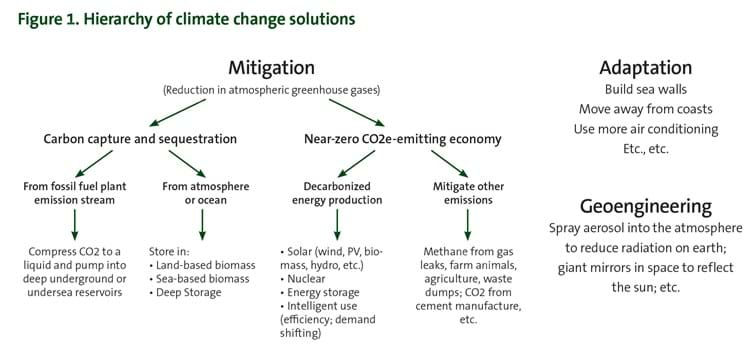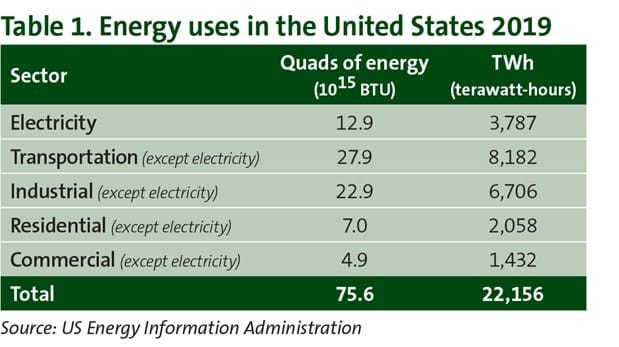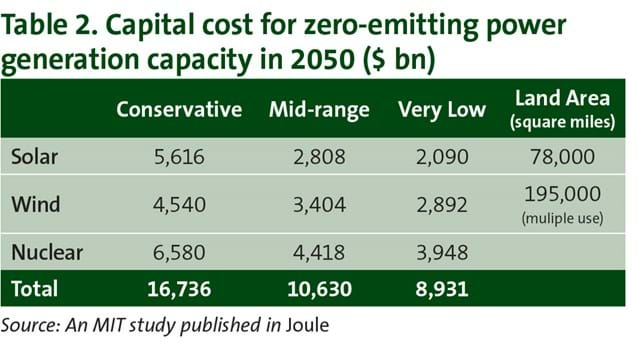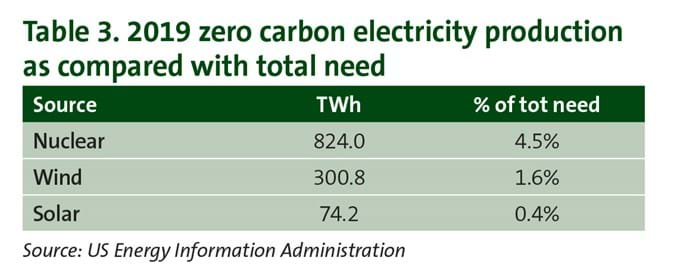Net zero as moonshot
by Michael Edesess, with M1K LLC in Hong Kong
President Biden's stated greenhouse gas reduction goal for the United States is "to create a carbon pollution-free power sector by 2035 and net zero emissions economy by no later than 2050."
Are these goals realistic, and what are the chances of meeting them?
It helps to lay out what sort of developments net zero by 2050 implies.
Ambitions and aspirations
Announcing a goal of zero net carbon emissions by 2050 is like announcing a moonshot and hoping that the ambition will carry us to the goal. But like President John F. Kennedy before announcing the moonshot goal in 1961, we need to have some preliminary calculations, informed by current knowledge of science and technology, to get at least a sense of what will be needed.
When Kennedy proposed to Congress, on May 25, 1961, the goal of landing a man on the moon before the end of the decade, it was not known exactly how this would be done, or if it was even possible. It wasn't even popular with the voting public.
Nevertheless, the act of setting the goal, and assigning the task of achieving it to the new agency NASA—the National Aeronautics and Space Administration—set in motion an unprecedented series of innovations and technological developments that ultimately succeeded in achieving the goal. It also spawned an impressive array of important spinoffs in the process, helping to spark the breakthrough technologies of the late 20th and early 21st centuries.
It didn't even cost the US taxpayer very much. The cost of the moonshot program, Project Apollo, from 1960 to 1973 was only $28 billion, or about $280 billion in today's dollars.
Those who now advocate that the United States should target net zero emissions of greenhouse gases by the year 2050 are advocating a new moonshot, with hopes for similar successes.
We do not know exactly how we can get there or if it is even possible. But it is believed that setting the goal will, like the goal of the moonshot, set in motion innovations and technological developments that will ultimately enable us to achieve that goal and create many positive spinoffs besides.
Hope, optimism, and ambition, however, are not by themselves enough to achieve a goal. President Kennedy and his vice president, Lyndon Johnson, consulted top scientists to assess whether it was possible, how difficult it would be and how it could be achieved.
Hierarchy of options
"Greenhouse gases" generally refers to gases emitted by electricity generation and other industrial activities that trap the escape of heat from the earth and retain it in the atmosphere and in the oceans. Carbon dioxide is the leading greenhouse gas, causing more than 80% of global warming. Consequently, greenhouse gas emissions are often simply called "carbon emissions."
The concern about greenhouse gas emissions is that the atmospheric and oceanic warming they cause can result in destabilizing events such as higher temperatures, ocean level rise, melting glaciers and ice caps, more energetic and unusual climate events such as storms, floods and droughts, and hotter and dryer timber contributing to forest fires.
Figure 1 shows all of the ways that we can address the problem of changes in climate caused by greenhouse gas emissions.

The principal options are mitigation, adaptation, and geoengineering.
Adaptation refers to ways to adapt to the changes that increased carbon in the atmosphere and the oceans may bring. Geoengineering refers mainly to ways to prevent part of the energy coming in from the sun from reaching the earth. Some adaptation will be necessary because warming will continue even if we reduce greenhouse gas emissions to zero. Accordingly, we should pursue research on geoengineering so that it can be used on an emergency basis if climate change quickly reaches an accute stage.
Of the three options, mitigation is the only way to achieve net zero emissions. Mitigation encompasses both reducing the amount of carbon dioxide and other greenhouse gases that go into the air and taking them out of the air.
There are two ways to reduce (mitigate) the amount of carbon in the air. One is to capture and store or reuse it (carbon capture and sequestration). The other is to stop or slow the emissions.
For achieving net zero emissions, it may be necessary to do both: to reduce the emissions to zero and to draw carbon out of the atmosphere.
Start with carbon capture and sequestration.
As Figure 1 shows, there are two main ways to capture carbon dioxide and keep it from returning to the atmosphere permanently or at least for a very long time. One is to take it out of the exhaust stream emitted from fossil-fuel-burning power plants and store it deep underground, and the other is to suck it directly out of the atmosphere.
What are the possibilities for both?
Carbon capture from fossil-fuel plant emissions is often abbreviated as CCS, for carbon capture and storage, or carbon capture and sequestration. It involves first capturing the carbon dioxide that forms the main component of the emissions stream from a coal- or gas-fueled power plant or industrial furnace. The carbon dioxide can then be compressed to liquid form and injected into secure caverns deep underground or under the ocean.
If all carbon dioxide could be captured from all fossil-fuel-fired power plants worldwide and stored permanently, it would mostly solve the problem of climate change caused by greenhouse gas emissions (though non-carbon greenhouse gas emissions such as methane and nitrous oxide would still remain). This solution would cause the least disruption to industrial society because we could continue to use fossil fuels as we have for the past 200 years, the period in which almost all technology development and economic growth in the history of the human race has taken place.
What would it take to do that? The coal consumed annually worldwide is currently about 8.5 billion tons, oil 5.3 billion tons and gas 3.1 billion tons, for a total fossil-fuel consumption of 16.9 billion tons.
The quantity of carbon dioxide emitted by burning these fuels is, however, 32.5 billion tons.
Why are the carbon dioxide emissions almost twice as great as the fuels being burned? Because carbon dioxide—CO2—is only one part carbon and two parts oxygen. The oxygen is pulled from the air when the fuel is burned. If this CO2 is buried deep underground, then twice as much oxygen, which came from the atmosphere, as carbon will be buried.
How close are we to being able to implement this much CCS? Right now, the total capacity of CCS in operation worldwide is less than 40 million tons—and these CCS plants are mostly not operating at capacity. They are able to capture and store less than 0.1% of all carbon emissions from fossil fuel plants.
There have been and will be NIMBY (not in my back yard) objections to CCS plants. In 1986, an eruption at a lake in the African country Cameroon released a cloud of hundreds of tons of carbon dioxide, which, being heavier than air, hugged the ground, killing 1,700 people. If there is a semi-irrational fear of radiation from nuclear power plants, there is at least a rational fear of leakage of carbon from deep underground storage. All the federal states in Germany have rejected it. If widespread CCS plants are proposed, there will undoubtedly be local opposition elsewhere, too.
Nevertheless, it is considered one of the major possible solutions to the carbon emissions problem, even though it has not been scaled up to a meaningful level and its costs are still estimated to be very high. But there is optimism that they can be reduced significantly in the future.
Nature-based capture
Another proposal is to plant trees to gather up the carbon from the atmosphere. Indeed trees do take up carbon, while they are growing. One can purchase "carbon offsets" from organizations that plant trees and get carbon credits for it.
Planting four trillion trees would take up all the carbon emitted annually worldwide, while the trees are growing. But it would consume 12.3 million square miles, more than four times the area of the United States, and it would compete with agriculture and stop working in about 25 years when the trees reach maturity. What would we do then?
It has been proposed to sequester carbon in soils by changing agricultural practices. The Intergovernmental Panel on Climate Change estimates that this could remove two to five billion tons of CO2 per year by 2050. This would comprise 6% to 15% of all current CO2 emissions. But soil can become saturated with carbon after 10 to 100 years depending on soil type, climate and management.
Neither of these ideas promises a major and permanent solution to the problem, though both could contribute to the solution on a temporary basis.
Another proposed method of carbon capture and sequestration in biological matter may hold more promise, but it is only in the very early stages of research. Seeding the ocean with chemicals—such as iron—to complete the set of chemical components needed for photosynthesis could cause growth of seaweed and other plant life, which would spur a massive increase in ocean bio-matter, capturing carbon that might then sink to the bottom of the ocean when the sea life thus created dies. But the total potential and costs are unknown, and there are huge questions of possible unintended consequences.
Direct air capture
It is possible to capture CO2 directly from the atmosphere that could then be stored deep underground. Technologies to do this exist, but they are currently very expensive.
It would not be the first time that a gas has been captured from the atmosphere to our great benefit. The Haber process, which captures nitrogen from the atmosphere, has enabled the production of fertilizer which has been crucial for the green revolution that produced massive quantities of food in the last 50 years, facilitating population growth and preventing waves of starvation.
But the air is 78% nitrogen. Although there is a lot of carbon dioxide in total, it comprises only 0.04% of the atmosphere. It is a lot harder to capture CO2 from the atmosphere than it is to capture nitrogen.
Nevertheless if the goal is truly net zero carbon emissions, then at least some extraction of carbon from the atmosphere will be necessary, because it will be extremely difficult to bring emissions from some activities, such as cement manufacture and methane emissions from agriculture and farm animals, down to zero.
Decarbonizing energy production
The final proposal to decarbonize the economy by bringing its emissions of greenhouse gases down to zero or nearly so has the most potential by a long shot.
Almost all of the emissions of carbon dioxide come from burning fossil fuels, producing energy in coal- and gas-fired power plants, using furnaces for heating buildings and industrial processes, and transporting vehicles.
The only way to bring all of these uses of energy down to zero emissions is to create electricity from zero-carbon sources and then electrify everything. This means that all on-road and off-road vehicles will have to be electric-powered, heating of buildings in most climates will be produced by electric heat pumps, heat for industrial processes will be created directly by electricity or from the waste heat produced by some forms of electric power generation, and ships and airplanes will use electricity or fuels created by electricity, such as hydrogen derived from water by means of electrolysis.
The only non-zero-emission sources of energy are renewable sources such as wind, solar radiation, water power from dammed rivers, biomass, wave energy, nuclear energy and geothermal energy. The most efficient way to use all of these sources of energy is to use them to generate electricity.
This is why the only way to create a zero emission economy is to electrify everything.
What do we need to do to electrify all U.S. energy?
Table 1 shows all of the energy uses in the United States in 2019.

Note that electricity currently accounts for less than one-sixth of the total energy use. Use of energy for transportation is currently more than twice our total electricity production.
General Motors has pledged to produce only electric vehicles by 2035. Unless electricity production is ramped up greatly in the next 15 years and all of that ramp-up is produced by zero-carbon-emitting electricity, most of those electric vehicles will run on coal- or gas-fired electricity.
Thus, Biden's pledge to create a carbon-pollution-free power sector by 2035 will put hardly a dent in carbon emissions by then—unless existing power production is converted to zero-carbon emissions and electric power production is greatly increased, and that increase consists mainly of zero-carbon emission electricity.
In order to reach the goal of zero emissions by 2050, zero-carbon-emitting electricity production will have to be increased by a factor of six.
What will that cost?
Table 2 shows estimated costs only for the power generation capacity.

The costs for power generation capacity alone will be in the $10 to $20 trillion range.
We are lucky that the costs for solar and wind power generation have declined so much, but the capital cost for the capacity to generate wind- and solar-powered electricity is only a small part of the cost.
Because of the intermittency of those power generation technologies, some means will be necessary to make power available where it is needed, when it is needed, whether or not the wind is blowing or the sun is shining.
We do not yet have a totally reliable and cost-effective solution to this problem. Long-distance transmission lines will help by geographically diversifying the sources of intermittent energy, but also adds a significant cost. If additional storage is needed, currently available solutions may be very expensive. Many trillions of dollars may need to be added to the cost estimates in Table 2 to cover this. Nevertheless, over the next 30 years, innovations and research can solve the problem. But no firm cost estimates can be given at present.
It should also be noted that while installations of wind and solar energy are being ramped up rapidly, zero-carbon-emitting electricity production is still a very small part of total electricity production, especially compared with what will be needed by 2050.

Many of the barriers to reaching the 2050 goal are not financial or monetary.
For example, many people, especially in the United States and Europe, do not want nuclear power plants or even wind power plants or high-voltage transmission lines or fossil fuel with carbon capture and storage near them.
Wind and solar power plants use large amounts of land. That land needs to be acquired or leased from someone who already owns it or has supervision over it, and the neighborhood needs to agree or at least not to fight it too hard.
Power plants affect other parts of the environment: wind and solar can harm birds and animals, nuclear power plants affect waterways, and decommissioning nuclear, wind and solar plants requires waste storage or recycling.
The bottom line
Though not impossible by any means, the feat of reaching the goal of net zero carbon emissions by 2050 will be a Herculean undertaking, perhaps comparable to the United States' production surge during World War II, but extended over 30 years instead of five.
A lot can happen in science and technology over 30 years. Therefore, the foremost need is for research and development in science and technology, which must be carried out at breakneck speed even as construction of existing technologies is carried out at breakneck speed.
These are not digital technologies we must construct, but solid structures of heavy metal and other weighty materials, the kind that hurt a lot when dropped on your foot. We have become accustomed in the 21st century to digital innovations proceeding from concept to realization extremely quickly. The technologies needed for the energy transition are very different; they may not be able to move so fast.
But as the moonshot achieved its goal because our aspiration and ambition were great, we may be able to achieve this goal too if we are similarly aspiring and ambitious.

